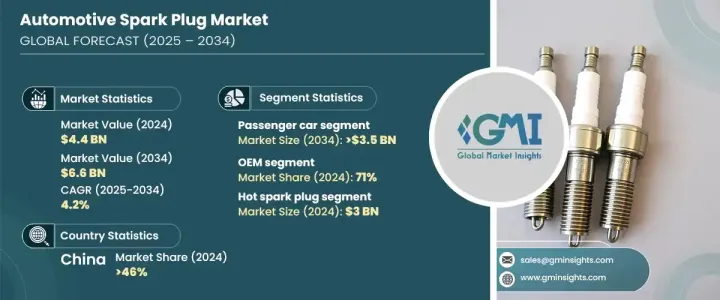
자동차용 점화 플러그 시장은 2024년에 44억 달러에 이르렀고, 2025년부터 2034년까지 연평균 복합 성장률(CAGR) 4.2%를 나타낼 것으로 예측됩니다.
이 성장 궤도의 주요 요인은 내연 엔진과 전기 모터를 통합한 하이브리드 자동차의 채용이 증가하고 있는 것입니다. 저연비 모델 개발에 주력하는 동안 고성능 점화 플러그의 역할은 엔진 효율을 최적화하고 배출 가스를 줄이는 데 더욱 중요해지고 있습니다.

하이브리드 자동차에 대한 소비자의 선호도는 점화 플러그 시장 주요 성장 촉진요인입니다. 업계 정세가 전동화로 이행해도, 점화 플러그가 자동차 업계의 기본 부품인 것을 계속 확실히 하고 있습니다. 또한, 세계의 경제 상황의 개선에 의해 자동차 보유율이 상승해, 자동차 생산 대수 증가, 나아가서 점화 플러그 수요 증가로 이어지고 있습니다.
| 시장 범위 | |
|---|---|
| 시작 연도 | 2024년 |
| 예측 연도 | 2025-2034년 |
| 시작 금액 | 44억 달러 |
| 예측 금액 | 66억 달러 |
| CAGR | 4.2% |
시장은 차량별로 승용차, 상용차, 이륜차로 구분됩니다. 완전한 전기자동차가 기세를 늘리고 있는 반면, 많은 소비자는 여전히 하이브리드 자동차를 선호하고 있으며, 점화 플러그 시장은 더욱 확대되고 있습니다.
판매 채널별로 시장은 상대방 브랜드 제조(OEM) 부문와 애프터마켓 부문으로 분류됩니다. 2024년에는 OEM 부문이 71% 시장 점유율을 차지했습니다. 이 부문 시장 세분화는 자동차 제조업체와의 장기 계약의 혜택을 받고 있으며 시장 경쟁에서 우위를 차지하고 있습니다.
중국은 세계의 자동차용 점화 플러그 시장에서 지배적인 힘을 유지하고 있으며, 2024년에는 시장 점유율 전체의 46%를 차지했습니다. 또한, 자동차 기술 혁신을 향한 해외와의 제휴나 국내 투자가 점화 플러그 기술의 대폭적인 진보를 촉구해, 이 분야에 있어서의 중국의 세계적 리더로서의 지위를 확고하게 하고 있습니다.
The Global Automotive Spark Plug Market reached USD 4.4 billion in 2024 and is projected to expand at a CAGR of 4.2% from 2025 to 2034. This growth trajectory is primarily fueled by the rising adoption of hybrid vehicles, which integrate internal combustion engines with electric motors. Despite the surge in electric vehicle (EV) production, hybrid vehicles continue to dominate, ensuring a sustained demand for spark plugs. As automakers focus on developing fuel-efficient models, the role of high-performance spark plugs becomes even more critical in optimizing engine efficiency and reducing emissions. Stringent global emission regulations are further pushing the market toward advanced spark plug technologies, fostering continuous innovation among key industry players.

The increasing consumer preference for hybrid vehicles is a major driver for the spark plug market. Automakers are actively investing in hybrid technology to meet evolving regulatory standards while providing better fuel efficiency. This shift ensures that spark plugs remain a fundamental component in the automotive industry, even as the landscape transitions towards electrification. Additionally, improving economic conditions worldwide are boosting vehicle ownership rates, leading to higher automotive production and, consequently, greater demand for spark plugs.
| Market Scope | |
|---|---|
| Start Year | 2024 |
| Forecast Year | 2025-2034 |
| Start Value | $4.4 Billion |
| Forecast Value | $6.6 Billion |
| CAGR | 4.2% |
The market is segmented by vehicle type into passenger cars, commercial vehicles, and two-wheelers. Passenger cars accounted for 56% of the total market share in 2024, with projections indicating a market value of USD 3.5 billion by 2034. The strong demand for passenger cars is driven by rising urbanization, growing disposable income, and an increasing number of consumers opting for gasoline-powered and hybrid models. While full-electric vehicles are gaining momentum, many consumers still prefer hybrid alternatives, further strengthening the spark plug market.
By sales channel, the market is categorized into Original Equipment Manufacturer (OEM) and aftermarket segments. The OEM segment dominated in 2024, holding a 71% market share. Automakers rely on premium-quality, durable spark plugs to ensure optimal vehicle performance and regulatory compliance. Manufacturers in this segment benefit from long-term contracts with automotive companies, giving them a competitive edge in the market. As vehicle production continues to rise, OEMs are expected to maintain their stronghold in the industry.
China remains the dominant force in the global automotive spark plug market, accounting for 46% of the total market share in 2024. The country's robust manufacturing infrastructure, coupled with its extensive automotive supply chain, makes it a key player in spark plug production and distribution. The growing emphasis on emission control policies and increased vehicle ownership in China is further propelling market expansion. Moreover, foreign collaborations and local investments in automotive innovation are driving significant advancements in spark plug technology, solidifying China's position as a global leader in this sector.